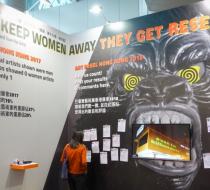The Guerrilla Girls attack gender and class bias at Art Basel Hong Kong Favorite
For more than 30 years, the Guerrilla Girls have travelled the world exposing sexism and inequality in the art industry, and this week they proved Hong Kong was no exception.
Three members of the anonymous feminist collective—calling themselves Frida Kahlo, Käthe Kollwitz and Zubeida Agha—spoke at the University of Hong Kong on Monday, dressed in their signature black outfits and gorilla masks.
This was the group’s first public appearance in Asia, and the timing was deliberate: the annual Art Basel Hong Kong was about to kick off and the Guerrilla Girls were crashing the party.
Speaking to HKFP, the Guerrilla Girls explained their new project, which investigates women’s representation at the international art fair. According to their research on last year’s iteration, 76 per cent of total artists shown were men; 37 per cent of galleries showed no women artists, and 29 per cent showed only one.
“We usually find a way to do some crazy project examining different institutions, so we looked into 2017 Art Basel Hong Kong, and soon on the wall of our new project there will be 2018—we’ll see whether it is better, worse, or no change,” said Kollwitz.
The new project applies the Guerrilla Girls’ favourite tactics. Since coming together in New York in 1985, the group has been notorious for its in-your-face political art, often citing embarrassing statistics and calling out artists and institutions by name. Members are protected by anonymity, allowing them to speak freely and to prioritise issues over personalities.
But as always, the key to their success is humour: in a cheeky move, they have placed their project analyzing 2018 Art Basel Hong Kong right outside the exhibition’s paid area. (Their booth features an oversized, looming gorilla face with zombie eyes.)
“Everything that we complained about being wrong with the art world is going to be super wrong at Art Basel Hong Kong,” Kahlo said. “It’s interesting to come and observe it, and perhaps do a little bit of espionage.”
While the project targeted the commercial aspect of Hong Kong’s art scene, the Guerrilla Girls were also going after museums. At their Monday appearance at HKU, they revealed—to audible dismay from the audience—that the Hong Kong Museum of Art and the M+ Museum of Visual Culture both have less than 20% women in their collections.
The Hong Kong Museum of Art told HKFP that the profile of its collections was a “reflection of the historical situation of the time,” as few female artists are recorded in art history or available in the art market.
The M+ Museum of Visual Culture did not respond to a request for comment.
The Guerrilla Girls went so far as to criticise Asia Art Archive, one of the sponsors for their trip, for inadequate diversity in its archives. When asked about their relationship with AAA, Agha said that the Guerrilla Girls are selective in who they work with, and they would collaborate with organisations that are “willing to be self-critical.”
For the Guerrilla Girls, diverse representation is not just about having better numbers—it is about democratising the production and consumption of art. Most of the time, they argue, the art market wants to “produce capital instead of culture”, so the super-rich end up having disproportionate influence. This makes the art world less accessible, especially to women.
“Why should you have to have a million dollars to create taste in the art world?” Kahlo added.
Many have sided with the Guerrilla Girls, and for as long as the group existed, people have asked how they could join. But even these provocateurs appreciate the need for change to happen from within the system: from gallery owners, collectors, academics, and students.
To start, heads of institutions should ensure there is equal representation on the staff level. “You can’t expect white men to tell the story of women of colour, they have no idea what they’re talking about,” Agha said. “So the people making the decisions should represent the community that the institution is supposed to represent.”
But what is most intriguing about the Guerrilla Girls is that, in the face of massive systemic injustices, more often than not they recommend doing something small, something on a personal scale. Complain. Be mischievous. Make inexpensive art. They would know: this was how they survived fighting the world for three decades.
“Over the years we’ve figured out a way to get by as a group, doing small exchanges rather than large exchanges,” Kollwitz said. “We don’t live off of huge sums coming from patrons. We engage in a lot of small exchanges: we sell T-shirts and posters and books, and we have lots and lots of people to support our work.”
“I think we created the model of the art world we want to live in.”







